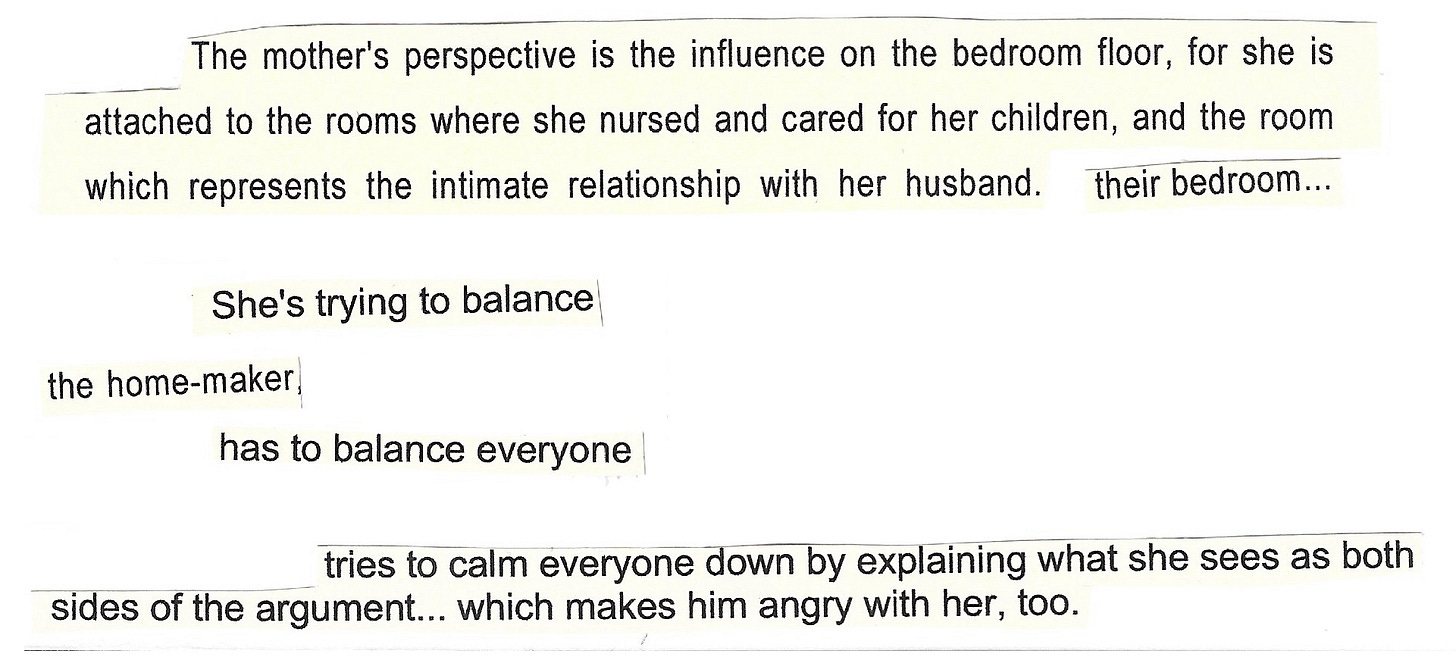A musical called four is the work of theoretical theatre* I’m currently sharing. Click here for the start of the story.
Here is connection.
In The Poetics of Space, Gaston Bachelard says:
“... the house furnishes us dispersed images and a body of images at the same time…”
I have seen the family, dispersed. Now I seek the body of images. Here is where connection lies.
The mother is connected to the rooms where she nursed and cared for her children, and to the room that represents the intimate relationship with her husband. One might say she connects Rooms into House (into Home?) using love.
She tries to balance everyone, to connect the family into one functional entity. She tries to see and also explain both sides of the argument, to help everyone else see each other and be part of the same family portrait. (Perhaps there is cubism in mothering.)
My old notes say she has no personal ‘voice’ but that which she echoes, and an echo is a connection of present with past. Her containers of stories are also connections of the present with the past.
They must move as a family and also as a home, past and all, else everything falls apart.
The son connects the inside of the house with the world outside, and his urge to leave connects the present with the future. I suspect he is the one who triggering the shouting up and down the stairs: a blustery attempt to blow wind into the sails of leaving this house.
Because of the shouting, the father is forced to connect with the stairs that connect the floors of the house to each other, the stairs that force the cellar to be connected to the whole. What makes it more powerful is that he built the stairs. He built them in the past, so he does not want to engage with the past. He doesn’t want to engage with the house move, either: he rejects the future too.
What he wants is to be fully present in the depths of irrationality. In that sense, he’s an anchor for a family intent on sailing away. The brightwork isn’t ready yet: the boat is unfinished. Perhaps he’s unsettled because no-one else seems to understand that.
The daughter breaks the fourth wall of reality. She opens up the house and connects it, not to the world outside, but to the dreamworld which is immense and timeless.
When I began writing this show, four lovely composers agreed to take on a character each, and we attempted a (generic) opening number as an experiment. I gave them all the same lyric: a literal statement about moving house. Each one used it to compose a song for their specific character, independently of the others, and only in consultation with me about their character.
I chose the mother’s voice to be the dominant one in this instance, so I gave all four songs to the mother’s composer and invited him to craft a single song that incorporated all four voices according to the way in which they might reach and affect the mother.
All five of us got together to hear this song. If the composers (who are all wonderful people and artists) will forgive my shaky twenty-five year-old memories, this is what I recall happening:
The father’s composer observed, somewhat tersely, that his work was barely present.
The son’s composer didn’t say much, had a meeting to get to, and rushed out the door.
The daughter’s composer waited until prompted, then said it was nice.
I’m not sure they noticed this happening.
Connection… In theory, what role/s are you playing in connection with this work? In theory, how are we bringing this work to life? In theory, who else are you inviting to engage with this work?
There might be more connection later. (Or not. Depends what sticks to you.)
Click here to read the previous post: daughter
Click here to read the next post: substance
*This may be theoretical theatre, but it’s still protected by Copyright © 2000-2025 by Jenifer Toksvig All Rights Reserved. Though I may be inspired by conversation and ideas, as long as you don’t infringe my copyright, anything you write in response to this belongs to you. Obviously. The Poetics of Space by Gaston Bachelard is translated into English by Maria Jolas, quoted here where referenced for the purposes of researching this work.








